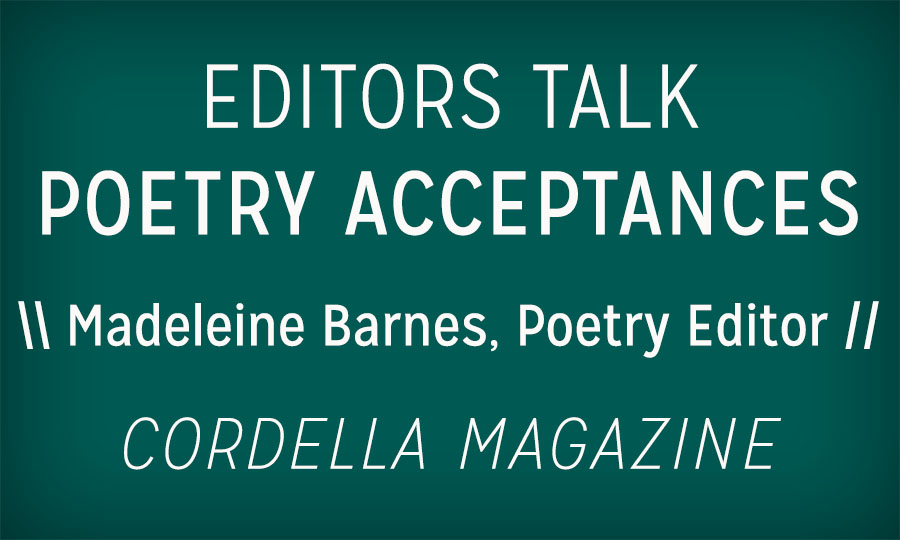Editors Talk Poetry Acceptances: Madeleine Barnes, Cordella Magazine

As a platform for emerging poets, our mission is to provide practical help for serious writers. The community lifts itself up together or not at all. In that light, we’ve been asking some great editors from around the literary community for their frank thoughts on why poems may get accepted/rejected from their own slush pile of submissions, and what poets can do to better their chances. Today, we’re speaking with Madeleine Barnes, Poetry Editor of Cordella Magazine.
What advice do you have for new poets who are submitting work?
Madeliene Barnes: We love to come across a poem that makes use of the push and pull of line breaks, silence and sound—you can feel the power and intention behind the words chosen, and your attention is sustained from beginning to end. It’s wonderful to read a poem where the lines break feel right and the stanzas are confident. We pay attention to how lines turn, and as Carl Phillips writes in The Art of Daring: Risk, Restlessness, and Imagination, “any poem that has resonance will contain tension.” We look for that tension. Imagery, musicality, and emotion are vital. We also love experimentation and poems that bend genre. Overall, we look for poems that are felt more than read, poems that have a strong voice and feel alive. Finally, and perhaps most importantly, we are drawn to poems that have been thought over and revised—it’s important for the poem to be the best possible version of itself. We want to read your most polished work.
If there were one craft technique that you wish poets would focus on, what would it be?
Don’t give up! Submitting is a tough process and you have to cultivate resilience and tenacity. Don’t let your sense of worth rely on the submission process. Aim to have countless rejections, and aim high. We get hundreds of submissions for each issue and have to make tough decisions as a team. Get competitive, get ambitious. A rejection is information—if your work is rejected, revisit your submission and see if there are ways to strengthen it.
Please read a journal’s submission guidelines. We often get submissions from men even though the magazine is clearly dedicated to women and non-binary writers and artists, which is a waste of everyone’s time.
Finally, be respectful of Editors! This is rare but sometimes writers will respond to a rejection and say that our decision was wrong. Trust that your work has been carefully considered and submit something else instead of insisting that your submission was a good fit.
If there were one craft technique that you wish poets would focus on, what would it be?
Sometimes it’s difficult to balance a poem’s narrative elements with a poem’s musicality and imagery. If you’re a poet who uses a lot of imagery, musicality, and abstraction, try to anchor your poem with a few narrative lines or moments so we can be present with you.
How many rejections have you faced and how do you deal with them?
Countless! I used to feel sad about it, and sometimes that feeling returns, but I have a tougher shell now. Getting a rejection means you’re putting yourself out there; you’re still in the arena and you’re not giving up. Each rejection is a badge of honor—it’s so much easier to hide away. Editing publications has taught me that I’m up against many outstanding writers. Persistence and a willingness to revise are half the battle. It takes courage to be vulnerable.
Does your publication seek out specific styles or aesthetics of poetry that writers and submitters should know about?
We are particularly interested in work that relates to a sense of spiritual life, ecology, and community, but we welcome submissions of all kinds that reflect one’s unique stories. Each issue of Cordella has a broad theme. We encourage submissions that relate to the theme on some level, but this is not a requirement for publication.
What book of poetry / craft would you always recommend to new poets?
The Art of Daring: Risk, Restlessness, and Imagination by Carl Phillips is great! Phillips considers what inspires human being to keep making, writing, living, and taking risks; he discusses revision, craft, what it means to give shapelessness a form. Poets can benefit from his reflections on the restless quality of the imagination, and the possibilities that lie within collaboration with other art forms like photography and the blues.
Mary Oliver’s Poetry Handbook is also a wonderful way to learn about the craft of poetry. She writes about all of the devices you have at your disposal as a poet and provides examples of how to use them successfully.
Is there anything else we should know about Cordella?
Along with our quarterly magazine issues, we are looking for submissions of writing, music, and visual art for our new Field Notes blog space on a continual basis. Sometimes a poem might not fit with an issue we’re putting together, but it resonates with us so much that we want to make space for it.
Madeleine Barnes is the Poetry Editor of Cordella Magazine, a publication dedicated to showcasing the work of women and non-binary writers and artists. Her second chapbook, Light Experiments (2019) is Porkbelly Press’ first ever zine-style photo chapbook. Her work has appeared or is forthcoming in places like Pleiades, [Pank], FENCE Digital, Blue Lyra Review, Crab Fat Magazine, and 45th Parallel. She’s the recipient of two Academy of American Poets poetry prizes, the Princeton Poetry Prize, the Gertrude Gordon Journalism Prize, and the Three Rivers Review Poetry Prize. She teaches at Brooklyn College. Visit her at madeleinebarnes.com.